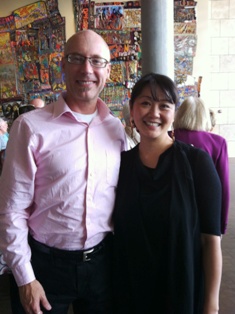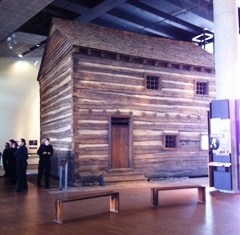
VAE, Concert:nova Collaboration Artistic Event of the Season
The setting was perfect for Sunday afternoon’s joint concert
by the Vocal Arts Ensemble and the instrumental ensemble concert:nova.

Entitled “Truth: Listening to Liberation,” the concert took
place on the second floor of the Underground Railroad Freedom Center, in front
of the two-story log Slave Pen that is the Freedom Center’s major exhibit. Planned in commemoration of the 150th
anniversary of the Civil War, the theme of the concert was freedom and
equality.

Music director Donald Nally led the 23-voice VAE and members of concert:nova in an all-21st-century program, with music by Alvin Singleton, Lansing McLoskey, Philip Lasser and David Lang. Not only are all the composers living (and American), but two were present at the concert, McLoskey and Lasser. McLoskey’s “Zealot Canticle,” commissioned by Nally and the VAE, was a world premiere.
All together, it was a remarkable event, surely one of the artistic highlights of the season.
Set to a text by Carman Moore, Singleton’s “Truth” opened the concert. Composed in 2005 in tribute to abolitionist and women’s suffragist Sojourner Truth, the half-hour work for chorus and ten instruments made a powerful impression. It began sparely and gently, with just percussion, guest artists Erica Drake and Yu-Chun Kuo, on marimba, vibraphone and vibraslap (the latter makes a rattling sound when struck). The six movements (alternating texted and wordless) traced her origins as a slave in upstate New York, to her life as a free activist for human freedom. The climax of the work was “The Inexorable Transformation,” where, inspired by an angel, she took the name Sojourner Truth.
Much of the text was sung declamatory style, and there was some vivid word painting, as on the word “work,” spoken and sung sharply, like the cut of a lash. Similarly, “Do you know me Jesus?” was sung in consonant harmony by women’s voices with harp accompaniment.
McLoskey’s “Zealot Chronicle,” for chorus and solo clarinet, is a setting of verses by Nigerian poet, playwright and novelist Wole Soyinka, winner of the 1986 Nobel Prize for Literature. The poems, numbers I and IX from “Twelve Canticles for a Zealot,” reflect upon the years Soyinka spent in prison for advocating human rights in Nigeria. Clarinet soloist was Ixi Chen, managing artistic director of concert:nova.
The first movement, “Renunciation,” evoked Soyinka’s delirium, as he endured hunger strikes and solitary confinement. Gradually the texture thickened, the men’s voices providing a slow-moving background for Chen’s rapid, convoluted lines. In the second movement, “Canticle,” a plea for peace, there was complex interaction between the chorus and the clarinet. Solo voices made impassioned cries, as the clarinet seemingly spiraled out of control, embodying the zealot in all its forms, whether good or evil. The final verse acknowledged the reality of submission, the choir breathing a soft, final triad and Chen a brief, ambiguous squiggle of sound.
In stylistic contrast to the first half, the second half opened with Lasser’s neo-romantic “The Dream Keeper” (2006) for chorus and eight instruments. A setting of poems from Langston Hughes’ eponymous set for young readers (1932), Lasser describes it as “a secular cantata on our common faith in hope, dreams and love.”
The first poem, “Passing Love,” sung a capella and repeated at the end, was tuneful and sweet, like an introduction to the set. Lasser’s treatment of the eight instruments was colorful and imaginative. “Winter Moon” utilized “thin” textures, reflecting the text (“How thin and sharp is the moon tonight”). In “Dreams,” there were persistent rhythms (“Hold fast to dreams”) and dissonant violin chords (“when dreams go, life is a barren field”). The concluding “Walkers with the Dawn” featured sparkling harp glissandos.
The concert ended with David Lang’s “Statement to the Court,” written for Nally’s Philadelphia choir The Crossing and premiered in 2010. No more powerful statement was made on this powerful concert than this one by American labor leader and socialist Eugene Debs when he was sentenced to federal prison in 1918 for speaking out against American participation in World War I. (The resonance of his words to the present day was all too apparent.)
Lang, whose Pulitzer Prize-winning “Little Match Girl Passion” was given its Cincinnati premiere by Nally and the VAE last season, has crafted words and music brilliantly here. The entire speech was declaimed against the steady beat of a drum, with rests between sentences to allow their meaning to penetrate. Members of the VAE, with concert:nova cellist Ted Nelson, broke in with individual phrases midway, adding a “one out of many” aspect to Debs’ words on the brotherhood of man. “In this country” became a repeated motif, as well. A standing ovation greeted the work’s conclusion.
The VAE performed an encore, James MacMillan’s “The Gallant Weaver” (text by Robert Burns), dedicated to VAE baritone Mark Wesley Brax, who died tragically in an automobile accident April 14, at the age of 23.